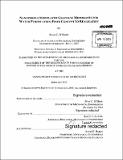| dc.contributor.advisor | Rohit N. Karnik. | en_US |
| dc.contributor.author | O'Hern, Sean C. (Sean Carson) | en_US |
| dc.contributor.other | Massachusetts Institute of Technology. Department of Mechanical Engineering. | en_US |
| dc.date.accessioned | 2015-07-17T19:52:18Z | |
| dc.date.available | 2015-07-17T19:52:18Z | |
| dc.date.copyright | 2015 | en_US |
| dc.date.issued | 2015 | en_US |
| dc.identifier.uri | http://hdl.handle.net/1721.1/97841 | |
| dc.description | Thesis: Ph. D., Massachusetts Institute of Technology, Department of Mechanical Engineering, 2015. | en_US |
| dc.description | Cataloged from PDF version of thesis. | en_US |
| dc.description | Includes bibliographical references (pages 133-144). | en_US |
| dc.description.abstract | Graphene, a single sheet of carbon atoms, may provide the foundation for a new class of highly permeable membranes for water purification and desalination. Though atomically thin, graphene exhibits both exceptional mechanical strength and imperviousness to atoms as small as helium. High-density, subnanometer pores within graphene have the potential for ultra-fast water permeance and high solute rejection as the atomic thinness provides little resistance to flow yet sterically hinders the transport of solutes larger than the pores. The resulting two-dimensional, nanoporous membrane is predicted to exhibit orders-of-magnitude permeability and selectivity enhancement over existing separation membranes for processes such as desalination of sea or brackish water, water softening, or nanofiltration. Herein, I will report our work to overcome the key challenges to the experimental realization of graphene membranes. I will describe methods to 1) fabricate a large area monolayer graphene membrane bonded to a porous polymer support, 2) create controlled, subnanometer pores through ion bombardment followed by chemical oxidation, and 3) seal leaks in the composite membrane by covering intrinsic graphene defects with hafnium oxide via atomic layer deposition and large cracks with an impermeable polymer through interfacial polymerization. We found the resulting graphene membrane to exhibit selective transport behavior consistent with recent theoretical models. At short chemical oxidation times, positively charged cations selectively permeated across the membrane over negatively charged anions, while at long chemical oxidation times small salts diffused across the membrane preferentially over larger organic dyes. Under forward osmosis, the membrane filtered from water a 0.8 nm-sized multivalent salt with a rejection rate of 67% and a 500 Da organic dye with a rejection rate of ~ 85% while exhibiting a water permeability in agreement with the analytical models. The agreement between the theoretical and experimental transport behavior suggests that, as predicted, nanoporous monolayer graphene will exhibit high permeance water filtration. While further optimization of membrane fabrication and pore creation processes will be required, our work significantly advances the field in this direction by developing procedures to probe transport, reporting the first experimental evidence of ionic and small molecule selectivity, and measuring water flux through nanoporous graphene membranes. | en_US |
| dc.description.statementofresponsibility | by Sean C. O'Hern. | en_US |
| dc.format.extent | 144 pages | en_US |
| dc.language.iso | eng | en_US |
| dc.publisher | Massachusetts Institute of Technology | en_US |
| dc.rights | M.I.T. theses are protected by copyright. They may be viewed from this source for any purpose, but reproduction or distribution in any format is prohibited without written permission. See provided URL for inquiries about permission. | en_US |
| dc.rights.uri | http://dspace.mit.edu/handle/1721.1/7582 | en_US |
| dc.subject | Mechanical Engineering. | en_US |
| dc.title | Nanoporous monolayer graphene membranes for water purification : from concept to realization | en_US |
| dc.type | Thesis | en_US |
| dc.description.degree | Ph. D. | en_US |
| dc.contributor.department | Massachusetts Institute of Technology. Department of Mechanical Engineering | |
| dc.identifier.oclc | 913414218 | en_US |
